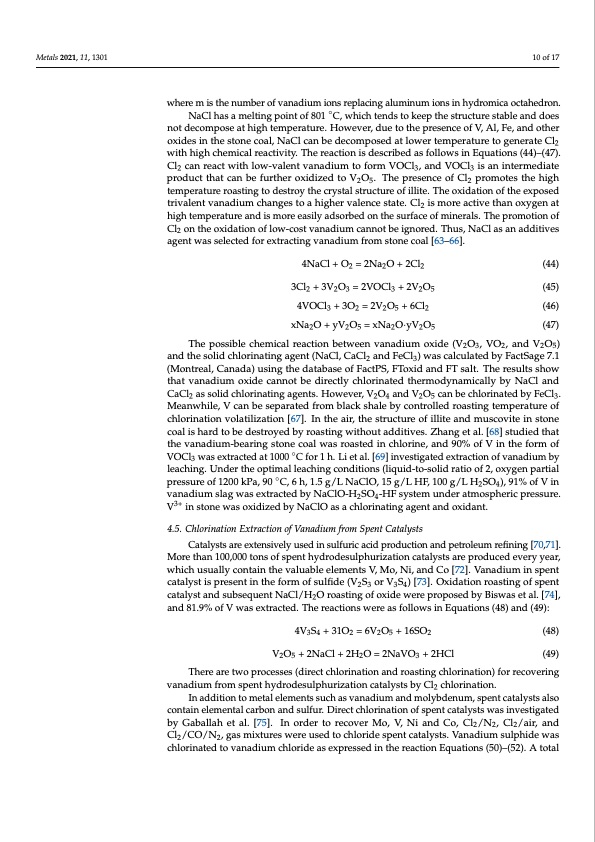
PDF Publication Title:
Text from PDF Page: 010
Metals 2021, 11, 1301 10 of 17 where m is the number of vanadium ions replacing aluminum ions in hydromica octahedron. NaCl has a melting point of 801 ◦C, which tends to keep the structure stable and does not decompose at high temperature. However, due to the presence of V, Al, Fe, and other oxides in the stone coal, NaCl can be decomposed at lower temperature to generate Cl2 with high chemical reactivity. The reaction is described as follows in Equations (44)–(47). Cl2 can react with low-valent vanadium to form VOCl3, and VOCl3 is an intermediate product that can be further oxidized to V2O5. The presence of Cl2 promotes the high temperature roasting to destroy the crystal structure of illite. The oxidation of the exposed trivalent vanadium changes to a higher valence state. Cl2 is more active than oxygen at high temperature and is more easily adsorbed on the surface of minerals. The promotion of Cl2 on the oxidation of low-cost vanadium cannot be ignored. Thus, NaCl as an additives agent was selected for extracting vanadium from stone coal [63–66]. 4NaCl + O2 = 2Na2O + 2Cl2 (44) 3Cl2 + 3V2O3 = 2VOCl3 + 2V2O5 (45) 4VOCl3 + 3O2 = 2V2O5 + 6Cl2 (46) xNa2O + yV2O5 = xNa2O·yV2O5 (47) The possible chemical reaction between vanadium oxide (V2O3, VO2, and V2O5) and the solid chlorinating agent (NaCl, CaCl2 and FeCl3) was calculated by FactSage 7.1 (Montreal, Canada) using the database of FactPS, FToxid and FT salt. The results show that vanadium oxide cannot be directly chlorinated thermodynamically by NaCl and CaCl2 as solid chlorinating agents. However, V2O4 and V2O5 can be chlorinated by FeCl3. Meanwhile, V can be separated from black shale by controlled roasting temperature of chlorination volatilization [67]. In the air, the structure of illite and muscovite in stone coal is hard to be destroyed by roasting without additives. Zhang et al. [68] studied that the vanadium-bearing stone coal was roasted in chlorine, and 90% of V in the form of VOCl3 was extracted at 1000 ◦C for 1 h. Li et al. [69] investigated extraction of vanadium by leaching. Under the optimal leaching conditions (liquid-to-solid ratio of 2, oxygen partial pressure of 1200 kPa, 90 ◦C, 6 h, 1.5 g/L NaClO, 15 g/L HF, 100 g/L H2SO4), 91% of V in vanadium slag was extracted by NaClO-H2SO4-HF system under atmospheric pressure. V3+ in stone was oxidized by NaClO as a chlorinating agent and oxidant. 4.5. Chlorination Extraction of Vanadium from Spent Catalysts Catalysts are extensively used in sulfuric acid production and petroleum refining [70,71]. More than 100,000 tons of spent hydrodesulphurization catalysts are produced every year, which usually contain the valuable elements V, Mo, Ni, and Co [72]. Vanadium in spent catalyst is present in the form of sulfide (V2S3 or V3S4) [73]. Oxidation roasting of spent catalyst and subsequent NaCl/H2O roasting of oxide were proposed by Biswas et al. [74], and 81.9% of V was extracted. The reactions were as follows in Equations (48) and (49): 4V3S4 + 31O2 = 6V2O5 + 16SO2 (48) V2O5 + 2NaCl + 2H2O = 2NaVO3 + 2HCl (49) There are two processes (direct chlorination and roasting chlorination) for recovering vanadium from spent hydrodesulphurization catalysts by Cl2 chlorination. In addition to metal elements such as vanadium and molybdenum, spent catalysts also contain elemental carbon and sulfur. Direct chlorination of spent catalysts was investigated by Gaballah et al. [75]. In order to recover Mo, V, Ni and Co, Cl2/N2, Cl2/air, and Cl2/CO/N2, gas mixtures were used to chloride spent catalysts. Vanadium sulphide was chlorinated to vanadium chloride as expressed in the reaction Equations (50)–(52). A totalPDF Image | Extraction of the Rare Element Vanadium

PDF Search Title:
Extraction of the Rare Element VanadiumOriginal File Name Searched:
metals-11-01301.pdfDIY PDF Search: Google It | Yahoo | Bing
Product and Development Focus for Salgenx
Redox Flow Battery Technology: With the advent of the new USA tax credits for producing and selling batteries ($35/kW) we are focussing on a simple flow battery using shipping containers as the modular electrolyte storage units with tax credits up to $140,000 per system. Our main focus is on the salt battery. This battery can be used for both thermal and electrical storage applications. We call it the Cogeneration Battery or Cogen Battery. One project is converting salt (brine) based water conditioners to simultaneously produce power. In addition, there are many opportunities to extract Lithium from brine (salt lakes, groundwater, and producer water).Salt water or brine are huge sources for lithium. Most of the worlds lithium is acquired from a brine source. It's even in seawater in a low concentration. Brine is also a byproduct of huge powerplants, which can now use that as an electrolyte and a huge flow battery (which allows storage at the source).We welcome any business and equipment inquiries, as well as licensing our flow battery manufacturing.| CONTACT TEL: 608-238-6001 Email: greg@salgenx.com | RSS | AMP |